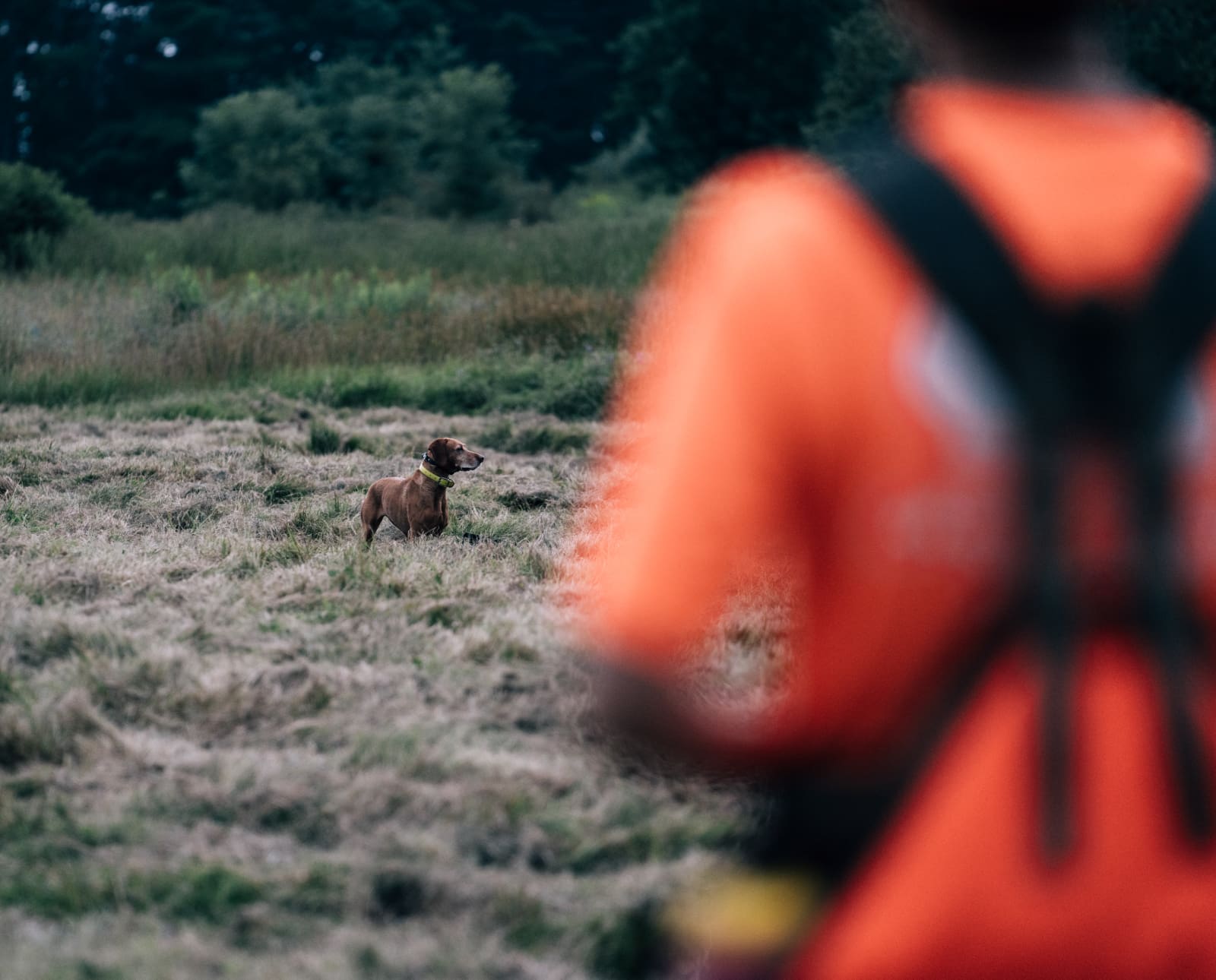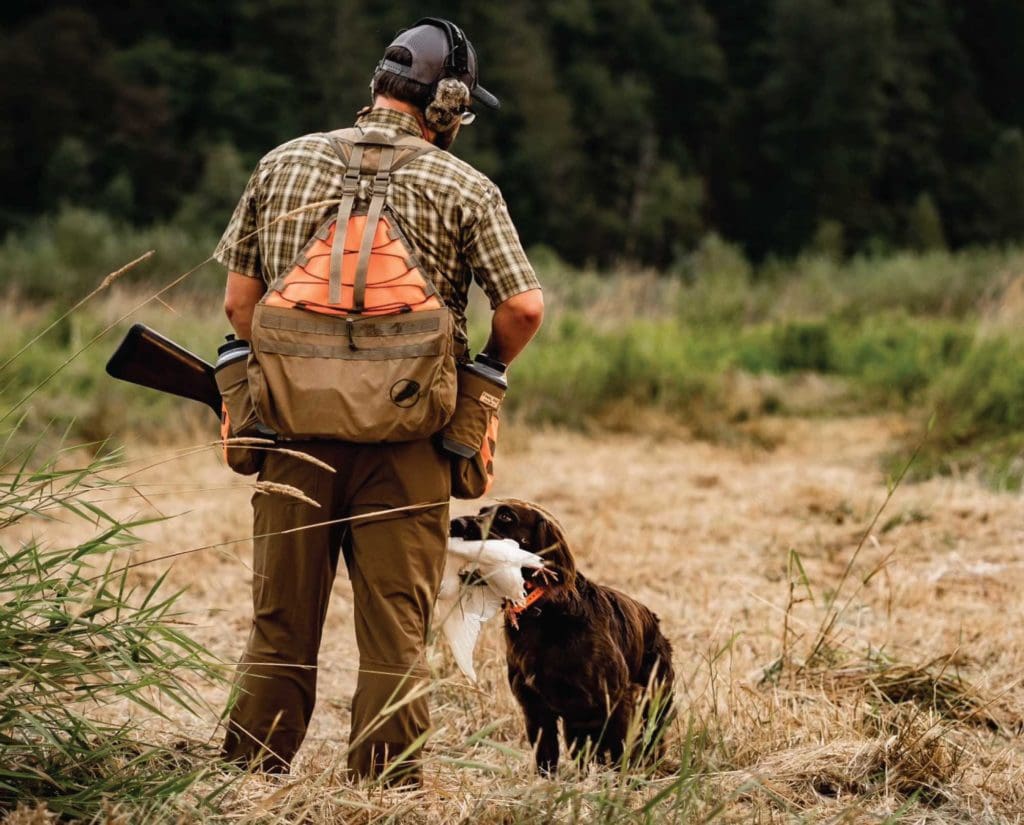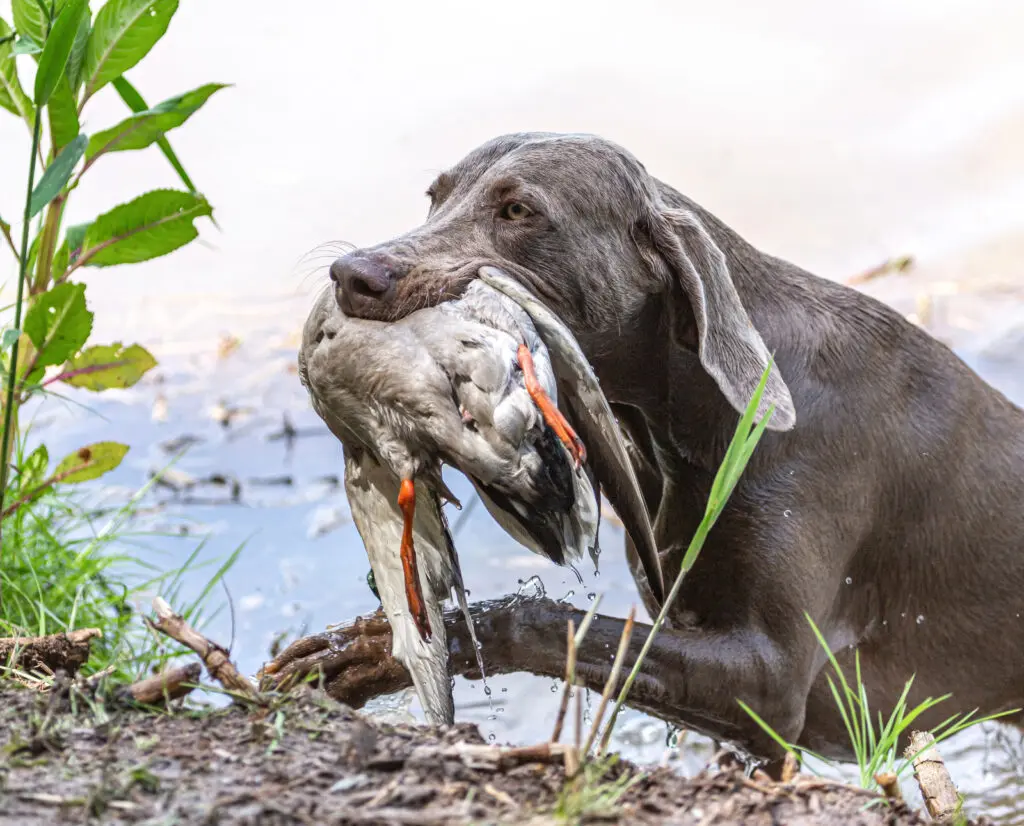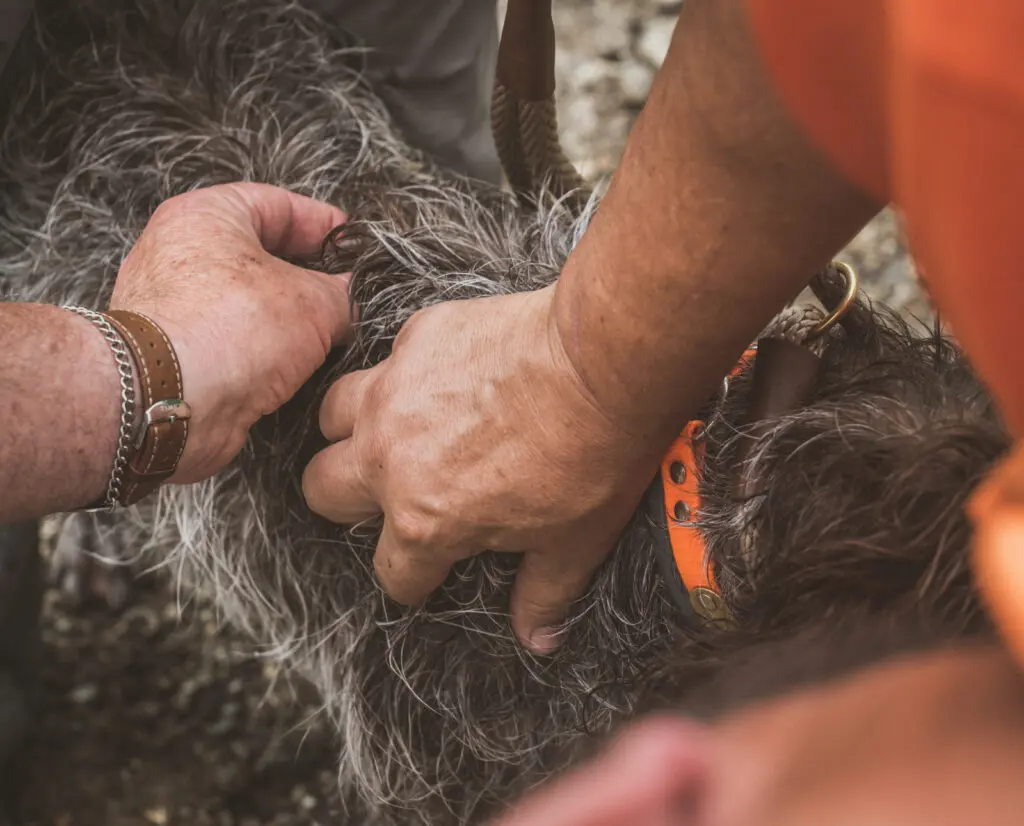Home » Hunting Dogs » NAVHDA Utility Test – A Complete Overview
NAVHDA Utility Test – A Complete Overview

Jennifer Wapenski is the Director of Operations and Managing Partner…
A look at the NAVHDA Utility Test, including test events, scoring, preparation, and what to expect for your hunting dog.
When it comes to evaluating hunting dogs—whether for breeding purposes or bragging rights—the methods and philosophies are as varied as hunters themselves. What constitutes a “good” hunting dog, and whose opinion counts? One hunter’s ideal dog could be a terrible match for someone else’s style, and vice versa.
Listen to more articles on Apple | Google | Spotify | Audible
Non-competitive hunt tests came about as an attempt to standardize the evaluation of hunting dogs at various levels. The tests aren’t perfect, but they at least provide a consistent measuring stick for assessing the natural and trained skills of a hunting dog. For the versatile pointing breeds, perhaps the most well-known system is the North American Versatile Hunting Dog Association (NAVHDA) testing system.
NAVHDA offers four levels of non-competitive hunt tests: the Natural Ability test, the Utility Preparatory Test, the Utility Test, and the national-level Invitational Test. Each of these tests is designed to mimic real-life hunting scenarios and assess the dog’s ability to focus and complete a given task. While the Natural Ability test is focused on the innate skills of pointing, tracking, and swimming, the higher-level tests introduce more trained subjects such as retrieving and steadiness.
What is the NAVHDA Utility Test?
A dog that successfully completes a Utility Test can be considered a “finished” dog. She is a worthy hunting companion because she is steady in the field and duck blind, can successfully recover dead or wounded game on land or in water, and has a high level of obedience at all times. Passing this test demonstrates that a dog should be able to successfully complete any task that might be encountered during an upland bird or waterfowl hunt.
The Utility Test builds from the foundation of the Natural Ability (NA) and Utility Preparatory (UPT) tests, with the assumption that the dog is now more physically and mentally mature and trained to a much higher level. As with the other tests, the setup is designed to reflect actual hunting conditions as closely as possible. Expectations of the dog’s performance and obedience are high.
READ: Aims Programs Test Rules

How to participate in a NAVHDA Utility Test
To be eligible for the Utility Test, dogs must be a NAVHDA-recognized versatile breed and the individual dog must be registered with NAVHDA. There is no minimum age or prerequisite tests; while it’s recommended to proceed through the testing levels in order, it is not required.
In addition to the dog’s registration, the handler and owner(s) of the testing dog must be members of NAVHDA. This is an annual membership that must be current in order to enter a dog into a NAVHDA test.
Individual chapters of NAVHDA host tests throughout the year. These tests are advertised online and published in NAVHDA’s Versatile Hunting Dog publication. Entry fees and process vary by individual chapter, so it’s best to contact the club’s Test Secretary for specific details. Generally speaking, test demand far outpaces the availability of test spots, so plan ahead and perhaps arrange for backup entries if you are waitlisted for your preferred test. It’s not uncommon for handlers to drop out close to the test date if they feel unprepared, so it’s a good idea to prepare for the test even if you don’t yet have a guaranteed spot.

How to prepare for the NAVHDA Utility Test
The Utility Test is a full day’s worth of evaluation on land and in the water. Before you run your first dog in a Utility Test, it’s a good idea to first observe a test to get a better idea of how the day is organized and what’s expected of the dogs. Anything you can do to reduce your test-day anxiety will go a long way toward helping you and your dog to be successful. Oftentimes, that just means eliminating some of the unknowns.
The Utility Test has a heavy emphasis on retrieving on land and in water, so it’s essential that you are confident in your dog’s ability to retrieve in a variety of scenarios. There will be a dead duck, a “wounded” (flightless) duck, and fresh-shot upland birds in any variety of conditions depending on how the shot sequence unfolded. Be sure your dog is reliable with warm, freshly-shot birds that may not be fully dead yet, and always make sure you train for situations more difficult than what you expect to encounter in the test.
The second emphasis that sets the Utility Test apart from lower levels of NAVHDA testing is the steadiness component on both land and water. To achieve the top score, your dog must be completely steady through the flush, flight, shot, and fall of the bird on land. She must also remain steady and quiet at the duck blind while shots are fired and a dead duck is launched into the water. Again, create training scenarios that are more challenging than what you expect at the test in order to be sure your dog can be successful in any circumstances.
Don’t just plan your training schedule around retrieving and steadiness, though. The duck search is a large component of the total score (see next section), and a top mark is required if you want that coveted Prize I. General obedience is also very important because your dog’s overall obedience will be judged throughout the test—especially heeling. Stress levels for both you and your dog will be extra high on test day, so it’s important that obedience and good heeling are second nature for your dog.

How NAVHDA Utility Tests are scored
Each subject of the Utility Test is scored on a scale from 0 to 4, with 0 meaning the dog completely failed to complete the task and 4 meaning the dog performed the task in an excellent manner. Subjects are assigned multipliers depending on the relative importance of the overall outcome. The maximum score for the Utility Test is 204 points. Like the NA and UPT, passing dogs are awarded “prizes” based on certain minimum scores in each category. Scores are determined by a team of three judges.
| Subject | Index Number (Multiplier) | Maximum Points Attainable | Prize I | Prize II | Prize III |
| Water | |||||
| Search for a duck | 4 | 16 | 16 (4) | 12 (3) | 8 (2) |
| Walking at heel | 2 | 8 | 6 (3) | 4 (2) | 2 (1) |
| Remaining by blind | 2 | 8 | 6 (3) | 4 (2) | 2 (1) |
| Steadiness by blind | 2 | 8 | 6 (3) | 4 (2) | 2 (1) |
| Retrieve of a duck | 3 | 12 | 9 (3) | 6 (2) | 3 (1) |
| Field | |||||
| Search | 5 | 20 | 15 (3) | 15 (3) | 10 (2) |
| Pointing | 4 | 16 | 16 (4) | 12 (3) | 8 (2) |
| Steadiness on Game | 3 | 12 | 9 (3) | 6 (2) | 6 (2) |
| Retrieve of shot bird | 3 | 12 | 9 (3) | 6 (2) | 3 (1) |
| Retrieve of dragged game | 3 | 12 | 9 (3) | 6 (2) | 3 (1) |
| Judged Throughout | |||||
| Use of nose | 6 | 24 | 24 (4) | 18 (3) | 18 (3) |
| Desire to work | 5 | 20 | 20 (4) | 15 (3) | 10 (2) |
| Stamina | 3 | 12 | 9 (3) | 9 (3) | 6 (2) |
| Cooperation | 3 | 12 | 9 (3) | 6 (2) | 3 (1) |
| Obedience | 3 | 12 | 9 (3) | 6 (2) | 6 (2) |
| TOTAL | 204 | 172 | 129 | 90 |
*Minimum Score For Each Prize Classification is Indicated in Parentheses.
NAVHDA Utility Test events
The Utility Test is divided into water and field events. The test can be conducted in any sequence at the judges’ discretion.

Water events
The water phase of the test often starts with the search for a duck. This event mimics a waterfowl hunting scenario where a duck has been wounded (rendered flightless) and has sought cover in vegetation within a pond. The dog must work independently to search the pond using its nose and intuition with minimal (or no) input from the handler. The judges are looking for the dog to complete an industrious, systematic search that lasts for approximately ten minutes. The dog is not required to find the duck, but if it does, the duck may be safely shot by a judge and then must be retrieved to hand.
Walking at heel is evaluated during the water group of events. A heeling “course” is established, although stakes are no longer used to mark a specific route. Instead, judges will instruct the handler to walk in a direction that includes one or more turns to evaluate the dog’s ability to walk calmly at heel. It is up to the handler whether to have the dog heel on or off lead, but the judging expectations are the same.
Typically immediately after the heeling sequence comes the blind steadiness sequence. The first of these subjects is remaining by the blind. The dog is left at the blind while the handler walks out of sight and fires two shots. The dog must remain quietly in position and calmly await the handler’s return. Once the handler is back to the blind, the dog is evaluated in steadiness by the blind. A hidden gunner fires a shot, then the handler fires a shot, then the gunner fires a second shot. A dead duck is thrown into the water, and the handler fires a second shot, as though the airborne duck has just been shot in flight. The dog must remain calmly in position throughout the sequence. Finally, the handler gives a command for the dog to retrieve the duck, at which point the dog is judged on its ability to swim through a decoy spread and successfully retrieve the duck back to the handler.

At the conclusion of the water events, each dog’s physical attributes are assessed and noted (teeth, bite, eyes, coat, and testes if applicable). This is not a judgment of the dog’s conformation against the breed standard, but is a quick assessment for any obvious faults that would hinder the ability to perform as a hunting dog. The physical attribute assessment has no impact on the dog’s score; it is just noted along with the results in the test records.
Field events
The main portion of the field event is conducted as though it were a typical upland bird hunt. The handler, judges, and two designated gunners enter the field and begin the hunt. The dog is evaluated on its field search as it looks for game in likely cover. Once game is found, the dog is evaluated in pointing. The handler should approach the dog, at which point the “pointing” portion of the evaluation ends as soon as the dog is aware of the handler’s presence. From this point forward, all of the dog’s actions are judged as part of steadiness on game. The handler must flush the bird and raise his or her gun as though about to shoot (but should not fire the gun). One of the designated gunners will shoot the bird. Ideally, the dog should stand motionless throughout this entire sequence.
Once the bird is down, the handler should release the dog to retrieve the shot bird. The dog is judged on how well it completes this task, including the condition of the bird once it is delivered to the handler.
The final event is the retrieve of dragged game. A dead bird—often a duck—is dragged for 100-200 yards and hidden out of view of the handler. This event is not a tracking exercise; rather, it is a test of how well the dog retrieves game while it is well outside of the handler’s influence. The dog is expected to locate and quickly pick up the game and return it to the handler without any commands or influence from the handler. Essentially, this is a test of your dog’s “honesty” when she knows that you can’t see her.
General subjects
Throughout the test, each dog is evaluated on their use of nose, desire to work, stamina, cooperation, and obedience. These characteristics are displayed during the various field and water test subjects and can be influenced by environmental factors such as especially hot or dry conditions. The judges take the entire day’s performance into account when evaluating the dogs on these subjects. Ideally, a good hunting dog is skilled at interpreting the scents picked up by her nose, has a clear desire to complete the given tasks, is physically capable of working all day long, has an obvious desire to work as a team with her handler, and willingly obeys commands. A dog that displays all of these qualities is likely to be a great hunting companion and truly enjoyable to work with.
Understanding the results of the Utility Test
At the conclusion of the test, the judges will convene to review their notes and arrive at a consensus for each day’s score. The results will be read aloud to the handlers and spectators. Any dog that receives a “prize” is considered to have passed the test. All dogs that receive a prize one in the Utility Test are eligible to run in the following year’s Invitational Test for the prestigious “Versatile Champion” title.
Whether or not the dog passed, the handler will end the day with a solid understanding of where the dog/handler team is in relation to their dog training and hunting goals. The Utility Test is strenuous for both the dog and the handler, and it’s always possible for a highly skilled dog to fail on any given day. As the judges often say, “We’ve only seen a small glimpse of what your dog can do on this one particular day.” Truly, anything can happen, but the goal is to prepare as best as possible.
When it comes to identifying quality breeding stock, Utility Test results say a lot about a dog’s natural abilities as well as its trainability for hunting subjects. It’s reasonable to expect that a high-performing dog will pass these traits on to future generations. Some breed clubs have established breeding standards that use NAVHDA test results, such as requiring one or both parents to have achieved a certain prize level in the Utility Test prior to breeding.
At the end of the day, whether you have passed the test or not, it’s a huge accomplishment to have prepared for the test and trained your dog to this level. A Utility-prized dog is at the top tier of all versatile hunting dogs and will be a valuable companion for finding and recovering game in any hunting scenario.
Jennifer Wapenski is the Director of Operations and Managing Partner at Project Upland Media Group. She has a lifelong passion for the outdoors, dogs, and wildlife; as an adult, she discovered that upland bird and waterfowl hunting were natural extensions of these interests. What started as initial curiosity soon escalated into a life-changing pursuit of conservation, advocacy, and education. Jennifer serves in a variety of roles such as the Breed Warden for the Deutsch Langhaar—Gruppe Nordamerika breed club and on an advisory committee for the Washington Department of Fish and Wildlife.




Enjoyable article. Narrator spoke too quickly. Hard to keep up with the excellent points provided. Recommend Narrator slow down from 1.5 speed to 1.0. Also Narrator missed pronounced “lead”. She pronounced it has in the manner describing a metal or element and not in the manner of the handler being the “Leader”. Recommend using the phrase “discharging the Shotgun” verses “Shot” when discussing the Steady By The Blind Sequence. This is because the word “Shot” can be both a noun and a verb depending upon the context it is used. Otherwise the Article was “Ausgezeichnet”.
We appreciate the feedback Timothy. We are always trying to improve.
My 3 year old Munsterlander is steady to flush shot and fall but will yip on occasion while waiting to be released. She does not do this during duck search or while waiting to retrieve.
Will she be marked down for this?
Thanks
Hunt
Hey Hunt, I’m not a judge so I asked one. He said they can be marked down if it is “excessive”. Obviously that’s subjective but worth working on it to make sure she’s not even more amped up and vocal with the higher stress of test day.